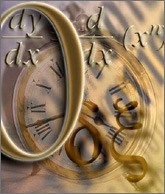Nils-Bertin Wallin in YaleGlobal Online:
 The Sumerians were the first to develop a counting system to keep an account of their stock of goods – cattle, horses, and donkeys, for example. The Sumerian system was positional; that is, the placement of a particular symbol relative to others denoted its value. The Sumerian system was handed down to the Akkadians around 2500 BC and then to the Babylonians in 2000 BC. It was the Babylonians who first conceived of a mark to signify that a number was absent from a column; just as 0 in 1025 signifies that there are no hundreds in that number. Although zero’s Babylonian ancestor was a good start, it would still be centuries before the symbol as we know it appeared.
The Sumerians were the first to develop a counting system to keep an account of their stock of goods – cattle, horses, and donkeys, for example. The Sumerian system was positional; that is, the placement of a particular symbol relative to others denoted its value. The Sumerian system was handed down to the Akkadians around 2500 BC and then to the Babylonians in 2000 BC. It was the Babylonians who first conceived of a mark to signify that a number was absent from a column; just as 0 in 1025 signifies that there are no hundreds in that number. Although zero’s Babylonian ancestor was a good start, it would still be centuries before the symbol as we know it appeared.
The renowned mathematicians among the Ancient Greeks, who learned the fundamentals of their math from the Egyptians, did not have a name for zero, nor did their system feature a placeholder as did the Babylonian. They may have pondered it, but there is no conclusive evidence to say the symbol even existed in their language. It was the Indians who began to understand zero both as a symbol and as an idea.
Brahmagupta, around 650 AD, was the first to formalize arithmetic operations using zero. He used dots underneath numbers to indicate a zero. These dots were alternately referred to as ‘sunya’, which means empty, or ‘kha’, which means place. Brahmagupta wrote standard rules for reaching zero through addition and subtraction as well as the results of operations with zero. The only error in his rules was division by zero, which would have to wait for Isaac Newton and G.W. Leibniz to tackle.
But it would still be a few centuries before zero reached Europe. First, the great Arabian voyagers would bring the texts of Brahmagupta and his colleagues back from India along with spices and other exotic items. Zero reached Baghdad by 773 AD and would be developed in the Middle East by Arabian mathematicians who would base their numbers on the Indian system. In the ninth century, Mohammed ibn-Musa al-Khowarizmi was the first to work on equations that equaled zero, or algebra as it has come to be known. He also developed quick methods for multiplying and dividing numbers known as algorithms (a corruption of his name). Al-Khowarizmi called zero ‘sifr’, from which our cipher is derived. By 879 AD, zero was written almost as we now know it, an oval – but in this case smaller than the other numbers. And thanks to the conquest of Spain by the Moors, zero finally reached Europe; by the middle of the twelfth century, translations of Al-Khowarizmi’s work had weaved their way to England.
More here.
